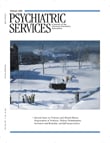Commentary: Commentary on the "Choice" Between Seclusion and Forced Medication
Veltkamp and colleagues' ( 1 ) study of patient preferences among involuntary measures used in psychiatric crises raises key issues about respect, self-determination, and use of coercive interventions in acute mental health settings. These issues are critical to the patient-centered transformation of the nation's mental health care system. As exploratory research, the potential for drawing definitive conclusions is limited.
For instance, the authors report that just before discharge, inpatients who had undergone seclusion, involuntary medication, or both judged these measures to be equally effective and aversive. Men but not women preferred seclusion over medications. Yet the study did not control for underlying variables that may critically affect consumer attitudes. The data do not show what prompted the use of an involuntary measure, how specific scenarios may have guided physician decisions about interventions, whether these scenarios were consistent across gender, or whether the differences are attributable to the circumstances in which coercive measures are taken or to issues of gender.
Further, the study did not consider patients' trauma histories, experiences with coercive interventions, the duration of seclusion episodes, consumers' perceived control over early release, and the lag between the occurrence of a seclusion or forced-medication episode and the patient's rating of preferences. Thus these factors show the need for caution in translating research findings into practice.
This research also raises larger issues about the infusion of recovery and self-determination into emergency psychiatric care. The central question presupposes that crises will occur on acute psychiatric units and necessitate the use of coercive measures. Given the niche that acute psychiatric units occupy in the health care continuum and the crisis circumstances that tend to trigger admissions, the first aspect of this formulation may be reasonable. But along with providing services to people having mental health crises should be a capacity to face emergencies with top levels of preparedness and expertise.
Concerns about the risks of coercive measures in psychiatry have been longstanding, culminating in the Hartford Courant 's well-known 1998 exposé of deaths and harms associated with seclusion and restraint. The series spurred a reexamination of psychiatric emergency care and public policies ( 2 ). The resulting changes in practice standards affirmed two critical and enduring principles: there are inherent physical and psychological risks in using these interventions, and the appropriate clinical and organizational posture should be to reduce and ultimately end their use. These procedures are now regarded as signaling failures in care ( 3 ).
Psychiatric units across the country have adopted these principles to varying degrees, often reporting dramatic decreases or even elimination of coercive interventions. Many successful programs have resurrected a philosophy of care that had been nearly abandoned through decades of cost cutting and expedience: that the clinical team strives to understand the individual being served and, in partnership with that individual, to identify the precursors of crises and strategies for their preemption. These changes encourage noncoercive approaches to mental health crises, including comfort rooms, conflict-management programs, and personalized crisis-management plans ( 4 ). When applied most thoughtfully, these approaches dovetail with the consumer's real world, in living arrangements where seclusion, restraint, and involuntary medications may not be viable options for managing stress.
Veltkamp and colleagues' research presents a false dilemma in seeking patients' preferences between two risky options; their use may indicate suboptimal care. Ostensibly, studies of consumer preferences shift away from professional authoritarianism and toward greater sensitivity to issues of dignity and self-determination. In focusing on two aversive options of dubious necessity, the research misses this laudable goal. Furthermore, in the absence of an explicit cautionary note, such research may be misconstrued as validating these practices. Crises, even when faced with seemingly good interventions, are intrinsically traumatic. What is needed is not a refined understanding of last-ditch coercive efforts but of how and why crises occur and how they can be eliminated.
1. Veltkamp E, Nijman H, Stolker JJ, et al: Patients' preferences for seclusion or forced medication in acute psychiatric emergency in the Netherlands. Psychiatric Services 59:209–211, 2008Google Scholar
2. Medicare and Medicaid programs; hospital conditions of participation: patients' rights; interim final rule. Federal Register 64:36070–36089, 1999Google Scholar
3. Roadmap to Seclusion and Restraint Free Mental Health Services. DHHS pub no SMA05-4055. Rockville, Md, Substance Abuse and Mental Health Services Administration, Center for Mental Health Services, 2005Google Scholar
4. Resource Manual for the Reduction of Seclusion and Restraint. Alexandria, Va, National Technical Assistance Center for State Mental Health Planning, 2003Google Scholar



